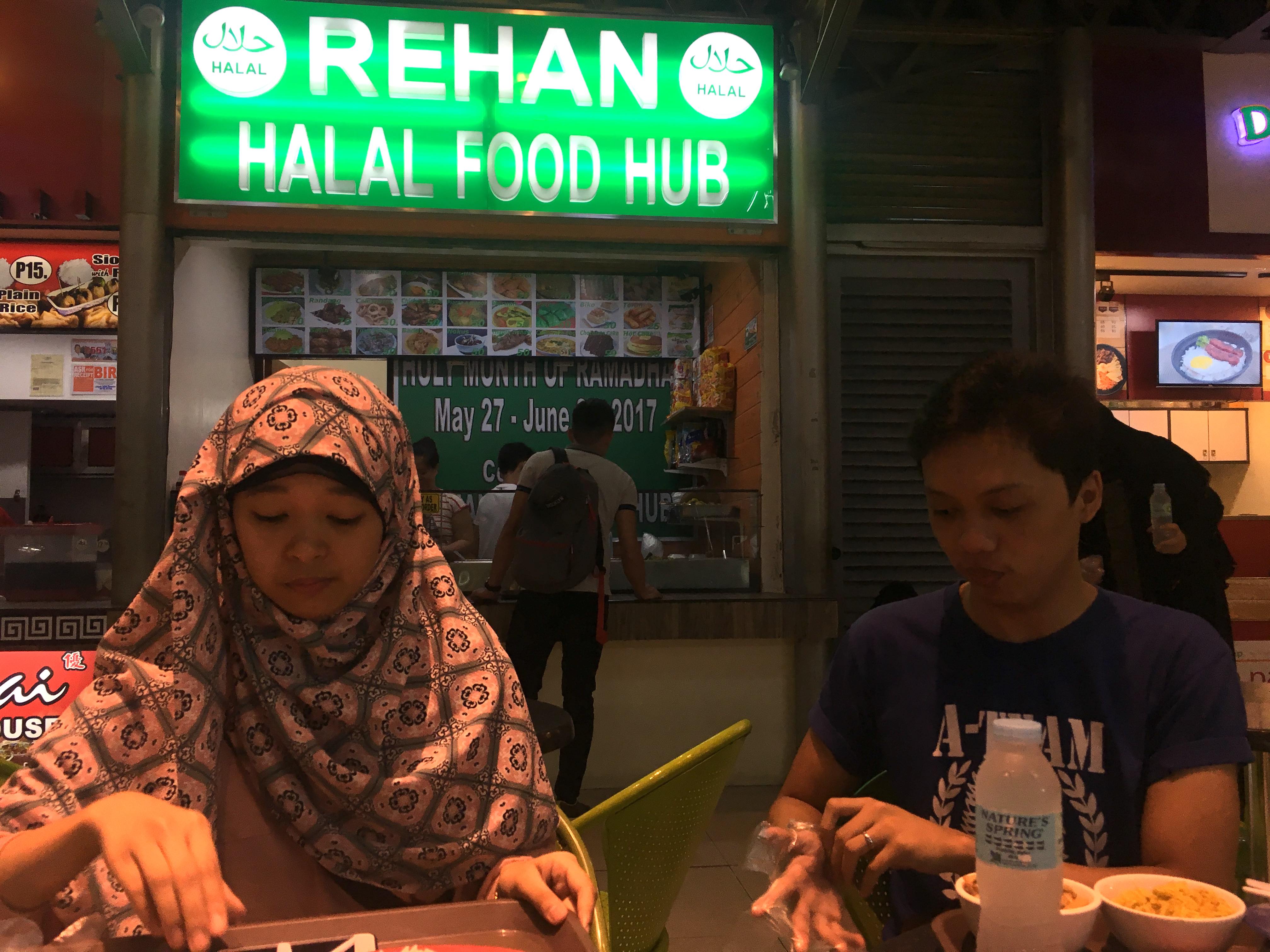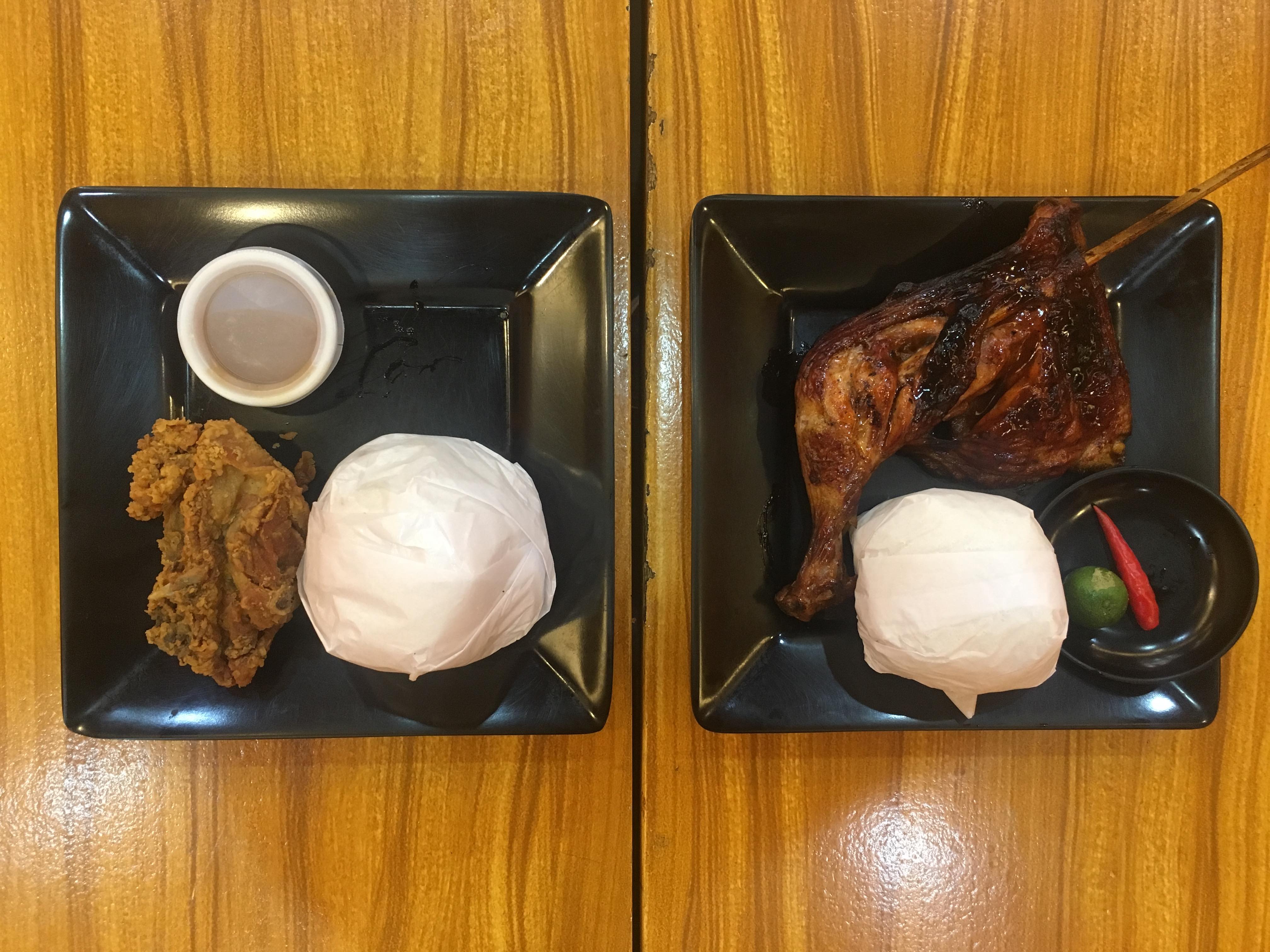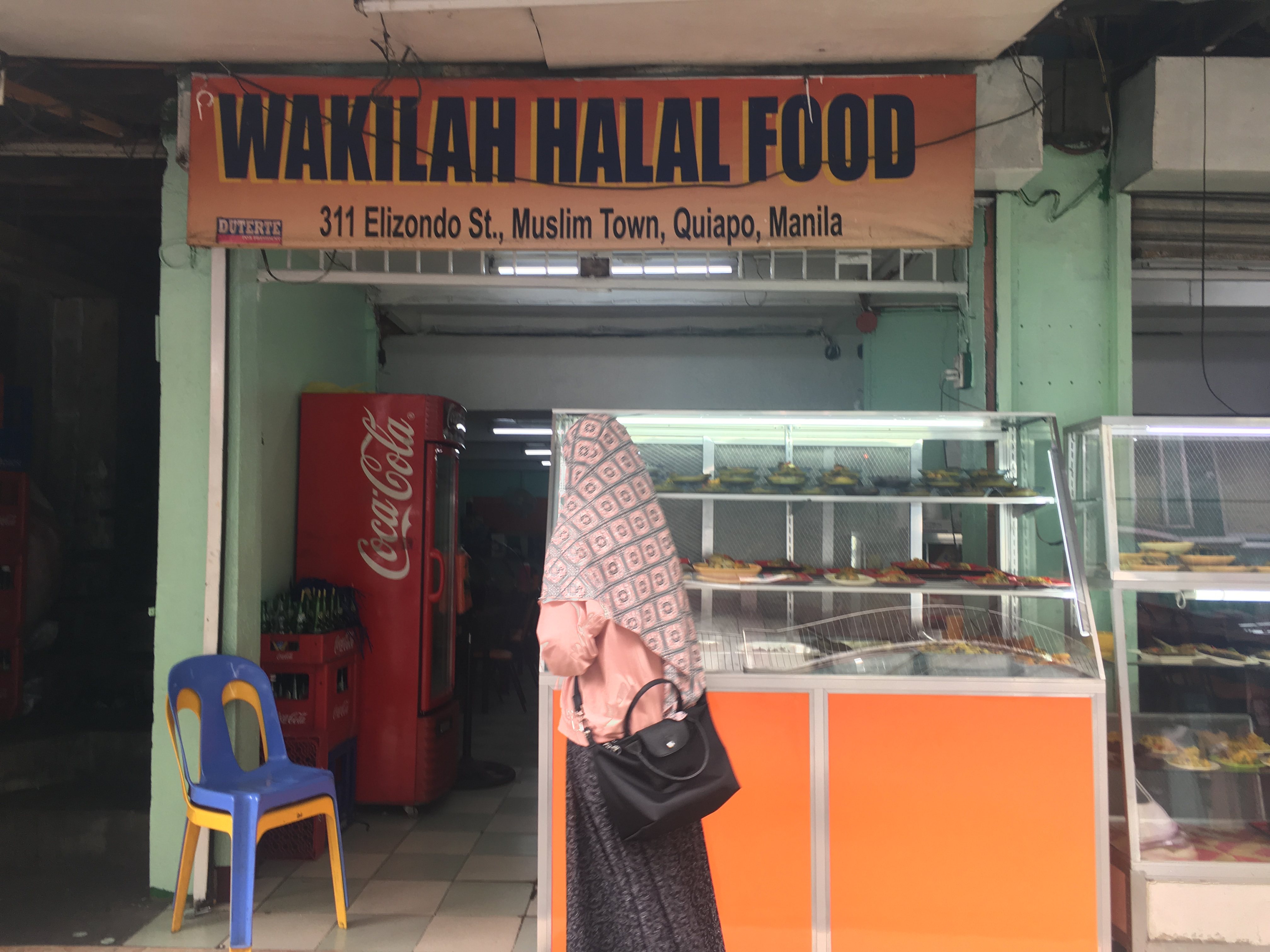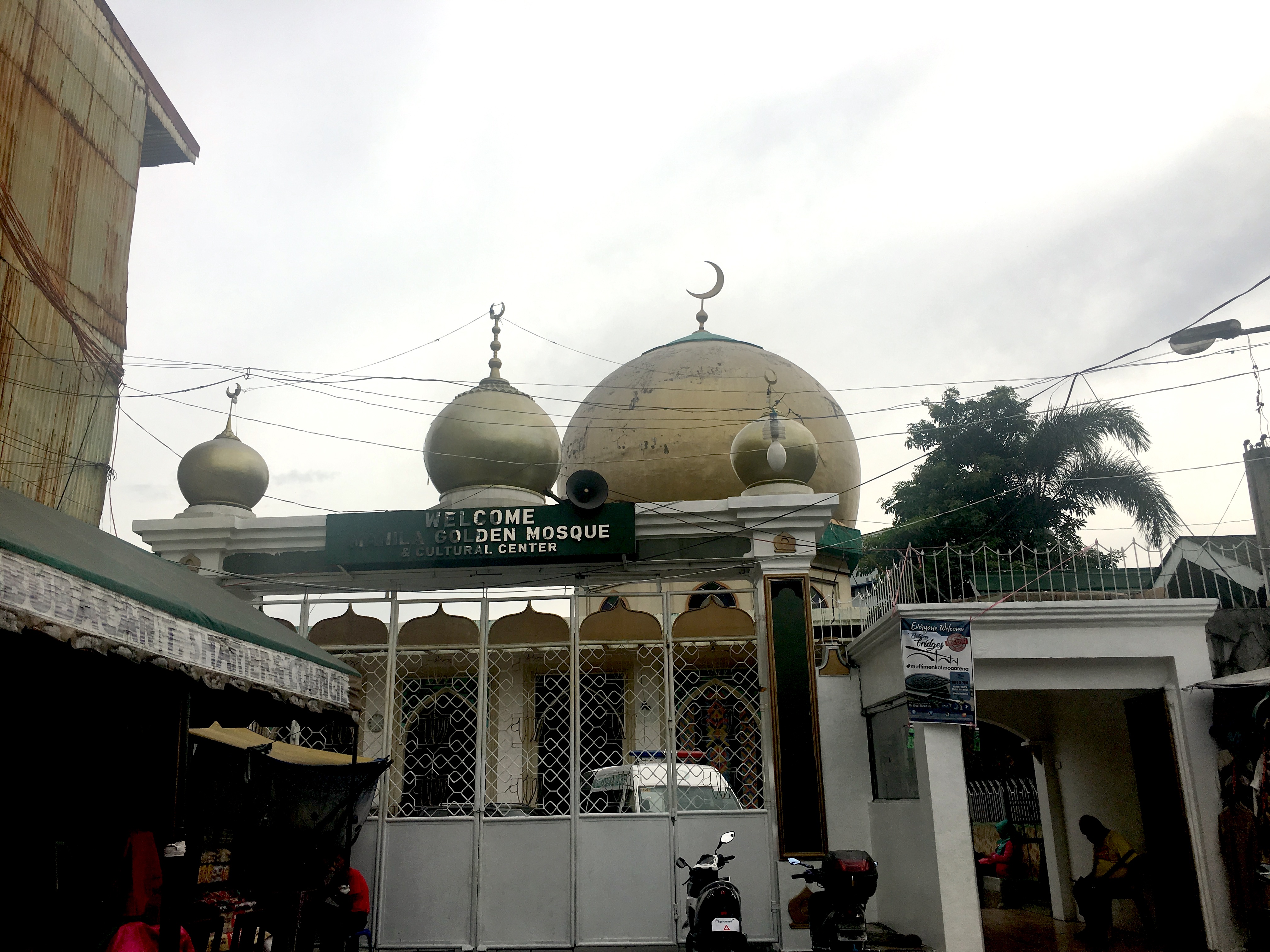It had been two months since 19-year-old Nurrol Izzah Mala got a taste of badak. She only eats her favorite meal — made from jackfruit, coconut milk, rice, and fish — a couple of times a year, whenever she goes home to the Muslim-majority city of Marawi in the southern Philippines.
The odds of finding badak in Manila are slim, she told Coconuts Manila late last month, and much less in a mall food court like the one she was in. Sharing the meal with her was her childhood friend Mohammed Gandamra.
Wearing plastic gloves over their right hands, the two college students ate one handful after another of rice doused in the spicy light brown sauce they grew up eating.

“This is my favorite, so my mom always cooks it for me,” Mala said in Filipino. “It tastes the same, but the way my mom cooks it is different. [Her way] of cooking it is my favorite.”
But it’s not just the familiar taste of home she looks for when eating out in the city, and satisfying a craving is the least of her food-related worries. As a practicing Muslim, her main concern is finding halal food, or food permitted by Muslim law, in a city that — like most of the Philippines — is predominantly Christian.
Until recently, developing the Philippine halal industry has taken a backseat in both the business and the government sectors. Most Filipinos could spend their whole lives not realizing this is a problem because it does not affect them and how they eat.
But this isn’t just about food. In a lot of ways, the lack of halal options in Manila also tells the story of the hundreds of thousands of Muslim Filipinos living in the capital: their struggle for inclusivity and the challenge of overcoming prevailing misconceptions about them.

A whole other world
According to the latest count by the Philippine Statistics Authority, there are about 5 million Muslims in the Philippines, with Islam being the country’s second-largest religion. While most Muslim Filipinos are originally from Mindanao, about 100,000 now live in Manila, many in Quiapo district. Gandamra, Mala’s friend from the food court, lives there.
The two took Coconuts Manila on a tour of Quiapo and pointed out places they usually eat. They all serve halal, or “permissible,” food items and don’t have any pork dishes, the most universally known haram (forbidden) food.
One of their favorites is Iza’s Chicken Corner, a fast food joint found in one of the neighborhood’s congested side streets that serves fried and barbecued chicken. It’s their alternative to places like Mang Inasal, a chain that mainly serves roasted chicken but has pork menu items as well.

Then there’s Moud Restaurant, a carinderia (food stall) that serves Maranaoan food similar to the food court stall the two tried earlier that day. It had rows of metal trays filled with delicacies like kinilaw (a raw fish dish similar to ceviche) and a burger corner with its own grill and deep fryer.
Finding halal food isn’t a problem in areas of the city with a sizable Muslim community like Quiapo, but it’s a lot harder everywhere else in Manila. And it’s been a problem forever.
“There have been Muslims since the Republic of the Philippines was established. Since then, there’s still no [system for halal certification]. People have tried, but there’s no follow through,” said Moslemen Macarambon Jr., a halal food advocate and former secretary general for the Halal International Chamber of Commerce and Industries of the Philippines, a non-government organization.
During a conversation with Coconuts Manila, he noted the striking difference between food establishments in Manila and Mindanao.
“There’s really only a few [options], because almost everywhere [in Manila] serves pork,” Macarambon said in Filipino.
At first look, that doesn’t ring true. Middle Eastern and Indian restaurants that serve halal meat and vegetarian dishes can be found all over Metro Manila. In 2015, the popular New York food truck The Halal Guys even opened multiple branches in the city.
But restaurants like these are too expensive for most Filipinos and are not practical for everyday consumption. Take a hard look at the eateries where average people eat every day, like street food pushcarts and carinderias, and it’s a whole other story.
“In Mindanao, there are carinderias owned by Muslims, so eating is not a problem. Compared to [Manila], if you eat in a carinderia, for sure there’s pork… It’s really difficult to eat. So now I just pack food for the office,” Macarambon said.
Mala, the college student, has a similar problem. She studies in the University of the Philippines-Diliman and knows of only one establishment on campus that serves halal food.
“At first, I was excited [to move to Manila] because of the thought of meeting new people, being in a new environment. It’s exciting at first, but eventually, I realized that it was difficult,” Mala said.
She described her meals as “monotonous,” because of how limited her options are. She’d like to explore more restaurants in Manila, like the ones in Maginhawa, a popular food street near her university, but it’s too much of a chore.
“I actually always force him to come with me [to try new restaurants],” Mala said, pointing to Gandamra. “But it’s difficult for us because when we get there, we don’t know what to order.”
She could cook at home, but even that can be difficult.
“I can’t buy meat in the mall because usually, they’re all stored in one area. Where they put the pork is also where they put the chicken… even when you buy canned goods, you still need to check if it’s halal certified,” Mala said before pulling out her phone to show a list of ingredients she avoids.
When a product doesn’t have the halal logo, she reads food labels to check if any of them have traces of pork. Gelatin is a no-no and so is bread made with lard.

As a student, Mala doesn’t have the luxury of spending hours in the supermarket and then hours more cooking her meals. She needs cheap, quick eats, and so most of the time, McDonald’s, Jollibee, and KFC, are her only options.
Her go-to orders are the chicken menu items, dishes that don’t technically contain pork, but are not fully halal either.
What is halal?
For something to be truly halal means a lot more than just skipping the bacon on a cheeseburger. It’s a process that starts at the farm and ends with the very plate on which your food is served.
“When halal products are transported, they can’t be beside non-halal [meat] like pig,” Department of Trade and Industry Assistant Secretary Abdulgani Macatoman told Coconuts Manila in Filipino. “When it comes to farms, the farm for cows or the farm for chickens can’t be beside or the same as the farm for pigs.”
The halal way of slaughtering animals is also specified by the religion. The animal’s throat must be cut by a practicing Muslim using a very sharp knife that will ensure a quick death.
“They have to be slaughtered properly because they’re also living beings. In other words, they are still the creation of our God. In other words, animals have souls too,” Macarambon said.
Strictly speaking, slaughtering can’t be done using a machine and other animals can’t see it happen. Halal meat also can’t be cooked in the same pan or oil as non-halal meat and cannot be placed on plates that have been used for non-halal food.
This specific, detailed, and expensive process is foreign to most Filipino business owners, one reason why restaurants rarely bother themselves with becoming halal certified.
“If you’re just a small restaurant and you only have one branch, it’s hard to justify to get [halal] certification, because it will cost you,” Macarambon explained about a process he said could cost up to PHP100,000 (US$1,926.96) annually.
The production of meat suppliers will also slow down. According to Macarambon, the modern way of mechanically slaughtering chickens can go through 3,000 heads per hour. This number is cut in half when slaughtering via halal methods.
But it’s not just higher costs stopping suppliers and restaurants from going halal. Sometimes, they simply don’t understand what halal is.

An uphill battle
“Some of my friends asked me ‘what will happen to you if you eat [pork]? Will you burn?,” Mala recalled.
She was sure her friends were joking, but also knows that the question came from a place of ignorance most Manileños occupy.
“I feel that people here have their own world. They don’t know about what’s happening in other parts of the Philippines, but in fact, we are just one country,” she said.
This is why for Asec. Macatoman, awareness is key to developing the halal industry. A common misconception he’d like to debunk is that halal food can only be eaten by Muslims.
“Halal is not just for Muslims, it’s for everyone,” he said.
In reality, the highest exporters of halal meat are not Muslim-majority countries. Al Jazeera reported in November that the top exporter of halal meat to Organization of Islamic Cooperation countries is Brazil, a predominantly Catholic country, just like the Philippines.
“When you look at the success of non-Muslim countries like us, [like] Thailand, why is their halal industry successful? A big element is the unity of Muslims in Thailand, or even Australia, or New Zealand,” Macatoman said.
This is what he would like to emulate in the Philippines, especially now that a law promoting halal food is in full swing.
Republic Act 10817, enacted in 2016, promotes the development of the halal export industry and has paved the way for some advancements in halal food production. In December, the Philippines officially became a full member of the International Halal Accreditation Forum, a network of countries that enforce universal halal standards.
And this is only the beginning, Macatoman said. The government plans to boost the industry by increasing halal exports and encouraging more meat suppliers and restaurants to get certified.
The DTI believes doing this will give the country a bigger share of the trillion-dollar halal food industry and improve tourism by appealing to more Muslim travelers.
“We have so many neighboring Muslim countries like Malaysia, Indonesia, Brunei. And what they always say is ‘when we go [to the Philippines], we get hungry, there’s no halal compliant restaurants’,” Macatoman said.
The law will also standardize the requirements for halal certification, educate small- and medium-sized businesses about the benefits of halal standards, and see the creation of a Philippine Halal Board as well as a National Fatwa Council to oversee the industry’s religious aspects.
Macatoman is confident that the local halal industry will flourish because it poses only benefits for all parties involved.
“There’s no reason for them not to follow [the law], because they’ll also benefit from it. Their market for halal products will become larger, so there’s no reason [to not follow]. They will surely follow this law,” Macatoman said after giving a rundown of benefits such as better quality meat and cleaner restaurants.
And in a perfect world, he’s right. Even without the added advantage of food safety, an increase in halal-certified food will pose no change for most people, while significantly improving the lives of Muslim Filipinos.
But because the Philippines is a secular state, it cannot require businesses to undergo halal certification. According to the law’s Implementing Rules and Regulations (IRR), no one is required to undergo the process.
“Halal certification of products, processes and services for domestic consumption or use is voluntary on the part of the producer, manufacturer, trader, retailer, or service provider,” section 13 of the IRR states.
The most the law can do is regulate halal certifying bodies and ensure that all establishments that claim to be halal are following the standards they’ve set.
And for Macarambon, the halal advocate, simply trusting businesses to follow suit may be a pipe dream.
“While there is no law that will penalize [not becoming halal certified], nothing will happen to the halal [industry],” he said. “I’m not being pessimistic but… that’s the reality. In the Philippines, if you don’t scare people with the law, why would they do it?”

There’s no place like home
“The weather there is really nice. People call it the Baguio of Mindanao,” Mala said of their hometown Marawi, comparing it to a popular tourist destination in the Luzon highlands known for its mountains and year-long sweater weather.
She has not been home since the city was attacked by ISIS-linked terrorists in May 2017.
“What I miss is the food, weather, and the comfort I feel there. Like you can be you there,” Mala said. “I feel like I’m more self-conscious here. I’m more conscious about other people. But when I’m there, it’s like ‘you’re home.’”
Gandamra feels the same way. “It’s like you’re in a place where you can express [yourself], you can do whatever you want. Like you’re free.”
For now, Quiapo is the closest Muslim community they have. It’s nothing like the home they described — the streets are crowded with vendors selling pirated DVDs and iPhone knockoffs, and the roads have a constant stream of slow-moving cars — but it also has little things that remind them of fond memories.
While walking around, Mala spotted a familiar delicacy in one of the makeshift shops on the street. It’s called pater, rice and meat wrapped in a banana leaf. She remembered how they would often eat it for lunch and proceeded to reminisce with Gandamra.

Here, they can relax a bit and not have to worry about whether the chicken was fried in lard or if the burger had pork meat in it. They don’t feel uncomfortable, because in this part of town, they’re just like everyone else.
“I feel like there’s a barrier between me and others because of my religion,” Mala said. “I feel people’s gazes. Especially when they look at you like you’re an alien.”
She wished Manila could be more inclusive. And this can be done, at the most basic level, through food.
“It would be nice to have more halal-certified establishments, because not everyone has time… Like us, we’re students. It’s hard for us to cook,” she said. “It has to be quick, so it’s better if you can just pass by for it and eat and be sure that it’s halal. But I don’t know how to make this happen.”
While improvements from the government are said to be on their way, there’s not much else she, or any other ordinary Muslim citizen can do right now but wait.
But even with this uncertainty, Mala is sure of one thing: despite all the trouble it causes her, she does not plan to leave Manila anytime soon.
“You can’t escape the reality that there are more opportunities here compared to Mindanao. So if you’re from a middle-class family, you’d sacrifice your comfort to work here, because you know you’ll earn more here compared to if you stay there.”



Reader Interactions